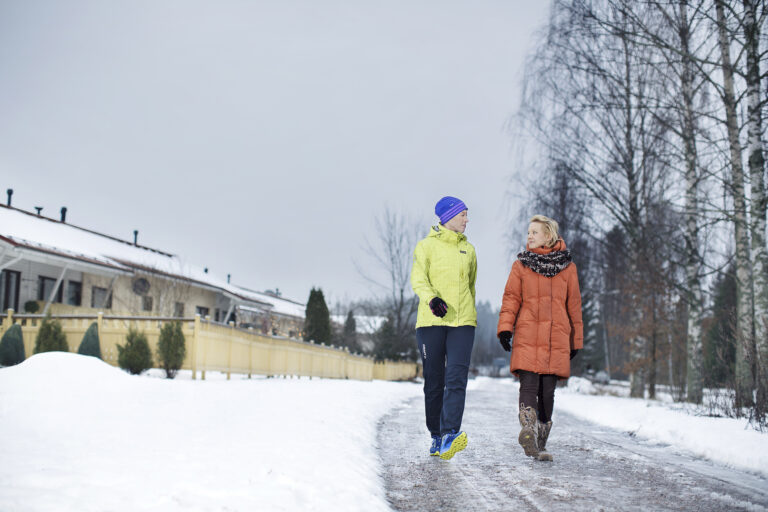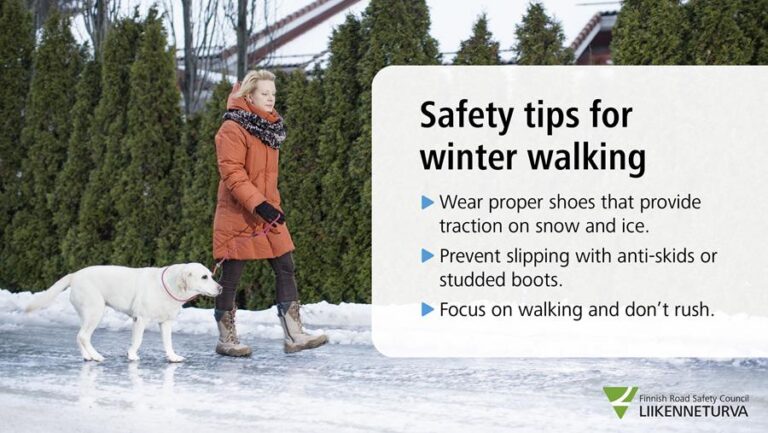Two out of five people have ended up in hazardous situations due to slippery shoes
According to a new survey by the Finnish Road Safety Council, up to 40 per cent of Finns say they have experienced a hazardous situation in traffic during the past year due to wearing shoes that are too slippery for the prevailing weather conditions. The ongoing ‘Pysy pystyssä’ anti-slipping campaign is here to remind us that by paying attention to the right footwear and focusing on walking, everyone can prevent slipping and falling.

Choice of shoes plays a significant role in preventing accidents involving slipping and falling. According to a survey* by the Finnish Road Safety Council, as many as two out of five Finns forty percent reported having experienced a hazardous situation involving wearing shoes that were not appropriate for the weather during the past year.
“Anticipation of slippery conditions plays a key role in preventing accidents involving slipping and falling. You will not be caught off guard in slippery conditions when you follow pedestrian weather warnings and prepare for slippery conditions with the appropriate footwear or anti-slip guards,” says Kaarina Tamminiemi, the chair of the ‘Pysy pystyssä’ campaign.
The daily commute is usually the most hazardous time in terms of accidents. You should remember that slippery conditions affect us all, regardless of the way we travel – and regardless of our age.
“Each one of us is a pedestrian at least for a short while during our day-to-day travel, even if it is just the distance between the car park and the front door to your workplace. People of all ages fall over, it is not just a problem for the elderly. On the contrary, most injuries caused by slipping and falling happen to working-age people. However, the injuries caused by slipping and falling tend to be more severe in the elderly compared to younger people,” Tamminiemi says and continues:
“When people of working age hurt themselves, the costs to their employer and society increase easily due to sick leave – in addition to physical pain and distress, of course.”
Your brain can’t multitask – focus on walking
When it is slippery outside, you should focus on walking. Walking on frozen surfaces and staying upright requires focus and an awareness of your surroundings so that you are able to notice areas that lack gritting sand or are uneven or otherwise slippery in time. You should wait to look at your phone when you get to your destination, not on the way.
“Your brain really can’t multitask, so in reality, multitasking only means switching between paying attention to one thing and then to the other. When you are trying to focus on two things at once, you are going to disrupt either one or both of these tasks. If you are immersed in using your phone, your thoughts and eyes are easily distracted, in which case slippery areas may take you by surprise as you walk,” says Petri Jääskeläinen, Planning Officer at the Finnish Road Safety Council.
If you need to use your phone while you’re walking, you should stop to do so – just like you would when you’re driving.
“For pedestrians, the possible consequences may not be as serious as for those who are driving but falling over always causes at least distress and often also physical discomfort. In keeping with the Finnish Road Safety Council’s Finnish language campaign slogan of only driving when driving, you could say that you should only walk when you walk,” Jääskeläinen says.

Prepare for slippery conditions:
– Pay attention to the choice of footwear – good shoes for slippery conditions have low, wide heels and an outsole made of soft material with good traction.
– Focus on walking. If you are paying attention to your mobile phone instead of walking, you can be taken by surprise by the slippery conditions.
– Be prepared. When you are alert, you are better equipped to avoid slippery areas.
– Use anti-slip guards – anti-slip guards attached to the shoes or permanent studs fixed to the shoes provide good traction.
– Check for warnings. You can check the pedestrian weather warnings on the Finnish Meteorological Institute website.
– Provide feedback on the maintenance of courtyards and passageways. Spreading gritting sand and clearing away snow helps others stay upright, as well.
– Maintain good physical health. Being in control of your own body and being in good physical condition help you to remain upright.
– Be aware of the fact that alcohol in your bloodstream elevates the risk of slipping and falling.
*Finnish road safety was surveyed in December 2018. The survey was executed by Kantar TNS Oy on behalf of the Finnish Road Safety Council. The total number of respondents was 1,009.
More information:
General information about the campaign
Senior Advisor Kaarina Tamminiemi, SOSTE Finnish Federation for Social Affairs and Health
Chair of the ‘Pysy pystyssä’ campaign (tel. 040 577 4614, kaarina.tamminiemi@soste.fi)
On focusing on walking and not paying attention
Planning Officer Petri Jääskeläinen, the Finnish Road Safety Council (tel. +358 (0)20 7282 322, petri.jaaskelainen@liikenneturva.fi)
On the prevention of slipping and falling accidents and the survey
Planning Officer Laura Loikkanen, the Finnish Road Safety Council (tel. +358 (0)20 7282 341, laura.loikkanen@liikenneturva.fi)
On pedestrian weather warnings
Senior Meteorologist Sari Hartonen, Finnish Meteorological Institute (tel. +358 (0)29 539 3444, sari.hartonen@fmi.fi)
Links:
The ‘Pysy pystyssä’ anti-slipping campaign (in Finnish): pysypystyssä.fi
Warnings (including weather reports for pedestrians): ilmatieteenlaitos.fi/warnings
The ‘Pysy pystyssä’ campaign promotes pedestrian safety in the winter. The campaign can be heard on the radio and seen on social media 14–27 January 2019. Follow: #pysypystyssä and @kotitapaturma.
‘Pysy pystyssä’ campaign partners:
Aivovammaliitto, EHYT Finnish Association for Substance Abuse Prevention, Finance Finland, City of Helsinki, Finnish Meteorological Institute, Finnish Association of People with Physical Disabilities, Finnish Road Safety Council, LähiTapiola, National Defence Training Association of Finland (MPK), Nikander ja Wiinikka Oy, Partioaitta, Sarva studded shoes, Finnish Ministry of the Interior, Ministry of Social Affairs and Health, Association of Finnish Local and Regional Authorities, Finnish National Rescue Association, Finnish Red Cross, SOSTE Finnish Federation for Social Affairs and Health, Finnish Swimming Teaching and Lifesaving Federation, Taitavat Suutarit ry, National Institute for Health and Welfare, Finnish Safety and Chemicals Agency (Tukes) and Finnish Institute of Occupational Health. The Funding Centre for Social Welfare and Health Organisations (STEA) also supports the campaign.
Can you use the information on this page?
Give Feedback
With this form you can give us feedback.
You may also be interested in
-

Keep your feet on the ground this festive season – despite the increased risk
If the pavements are slippery during the festive season, it is reflected in a peak in pedestrians falling accidents and people hurting thems… -

One in three finds studded shoes or anti-slip guards too cumbersome – despite obvious benefits
The ‘Pysy pystyssä’ campaign reminds you that you can be prepared for slippery winter conditions by wearing studded shoes or anti-slip guard… -

Take your time, avoid rushing and stay on your feet when it is slippery outside
Slippery streets may take pedestrians by surprise in the early winter, when they have not gotten used to icy streets yet. The ‘Pysy pystyssä… -

Roughly one in three Finns will slip and fall during the winter – you can prevent falls by making small changes
More than one million accidents occur each year in Finland, of which more than one third are various kinds of slips and falls. You can also …
